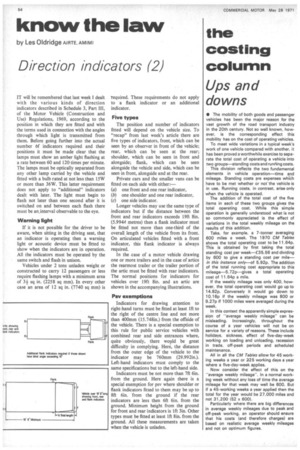know the law
Page 62

If you've noticed an error in this article please click here to report it so we can fix it.
by Les Oldridge AIRTE. AMIM I
Direction indicators (2)
IT will be remembered that last week I dealt with the various kinds of direction indicators described in Schedule 3, Part III, of the Motor Vehicle (Construction and Use) Regulations, 1969, according to the position in which they are fitted and with the terms used in connection with the angles through which light is transmitted from them. Before going further into the actual number a indicators required and their positions it must be made clear that the lamps must show an amber light flashing at a rate between 60 and 120 times per minute. The lamps must be optically separated from any other lamp carried by the vehicle and fitted with a bulb rated at not less than 15W or more than 36W. This latter requirement does not apply to "additional" indicators dealt with later. The light must begin to flash not later than one second after it is switched on and between each flash there must be an,interval observable to the eye.
Warning light If it is not possible for the driver to be aware, when sitting in the driving seat, that an indicator is operating then a warning light or acoustic device must be fitted to show when the indicators are in operation. All the indicators must be operated by the same switch and flash in unison.
Vehicles under 2 tons unladen weight or constructed to carry 12 passengers or less require flashing lamps with a minimum area of 3+ sq in. (2258 sq mm). In every other case an area of 12 sq in. (7740 sq mm) is required. These requirements do not apply to 'a flank indicator or an additional indicator.
Five types The position and number of indicators fitted will depend on the vehicle size. To "recap" from last week's article there are five types of indicators, front, which can be seen by an observer in front of the vehicle; rear, which can be seen at the rear; shoulder, which can be seen in front and alongside; flank, which can be seen alongside the vehicle and side, which can be seen in front, alongside and at the rear.
Private cars and the smaller vans can be fitted on each side with either:—
(a) one front and one rear indicator, (b) one shoulder and one rear indicator, (c) one side indicator.
Longer vehicles may use the same type of indicators but if the distance between the front and rear indicators exceeds 19ft Sin. (5.9944 metres) then a flank indicator must be fitted not more than one-third of the overall length of the vehicle from its front. On articulated vehicles fitted with a front indicator, this flank indicator is always required.
In the case of a motor vehicle drawing one or more trailers and in the case of artics the rearmost trailer or the trailer portion of the artic must be fitted with rear indicators. The normal positions for indicators for vehicles over 19ft 8in. and an artic are shown in the accompanying illustrations.
Psv exemptions Indicators for drawing attention to right-hand turns must be fitted at least 1ft to the right of the centre line and not more than 400mm (15.748in.) from the offside of the vehicle. There is a special exemption to this rule for public service vehicles with combined rear and side entrances where, quite obviously, there would be great difficulty in complying. Here, the distance from the outer edge of the vehicle to the indicator may be 760mm (29.992in.). Left-hand indicators must comply to the same specifications but to the left-hand side.
Indicators must be not more than 7ft 6in. from the ground. Here again there is a special exemption for psv where shoulder or flank indicators fitted to them may be up to 8ft 6in. from the ground if the rear indicators are less then 6ft 6in, from the ground. Minimum height from the ground for front and rear indicators is lft 3M. Other types must be fitted at least lft Sin, from the ground. All these measurements are taken when the vehicle is unladen.










































































































